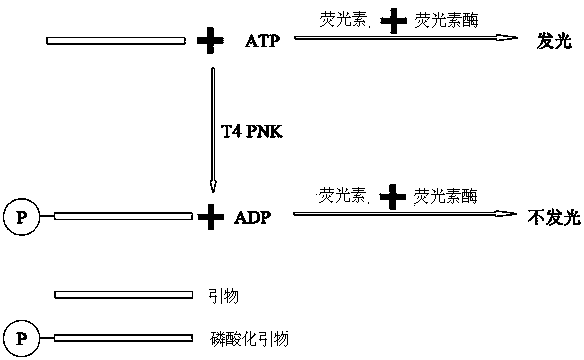Method for quantitatively determining activity of T4 polynucleotide kinase
A technology of polynucleotide and kinase activity, which is applied in the determination/inspection of microorganisms, biochemical equipment and methods, etc., which can solve the problems of quality limit, cumbersome operation process, and easy radioactive pollution, etc., and achieve easy operation and operation Simple steps and quick response
- Summary
- Abstract
- Description
- Claims
- Application Information
AI Technical Summary
Problems solved by technology
Method used
Image
Examples
Embodiment 1
[0022] Example 1. Establishment of a method for measuring T4 polynucleotide kinase activity by chemiluminescence
[0023] Phosphorylation reaction:
[0024] T4 polynucleotide kinase is NEB M0201;
[0025] Oligonucleotide substrate: 5'-acggattcatatttcatcct-3'
[0026]
[0027] temperature time 37℃ 30 minutes 4℃ Keep
[0028] Luciferase reaction:
[0029]
[0030] *T4 polynucleotide kinase reaction product corresponding to tube number was added to tubes 1-12.
[0031] Chemiluminescence detection
[0032] Detection was performed with a GloMax® 96 Microplate Luminometer (promega Cat.# E6501). The test results are as follows:
[0033] Enzyme amount of T4 polynucleotide kinase (mU) Chemiluminescence value 1024 241. 512 1050. 256 1086. 128 1578. 64 3236. 32 14675. 16 49947. 8 91598. 4 116186. 2 117052. 1 117184. 0 117963
[0034] This result indicated that T4 PNK could...
Embodiment 2
[0036] Example 2. Drawing of T4 polynucleotide kinase activity-fluorescence intensity curve and EC50 calculation
[0037] Take the log value of the T4 polynucleotide kinase activity unit (mU) of 2#-12# as the abscissa, and the fluorescence intensity as the ordinate, and use GraphPad Prism5 to make a nonlinear regression curve. We found that these data points can be well fitted with an inverted sigmoid curve, such as image 3 shown.
[0038] By repeating the experiment several times and calculating the half-maximal effect concentration (EC50) of the curve, we found that the EC50 value remained stable across multiple experiments:
[0039] experiment EC50 (mU) 1 13.76 2 13.54 3 14.37 4 13.58 5 14.07
[0040] Mean (mU) 13.86 Standard deviation SD (U) 0.35 Coefficient of Variation CV (%) 2.54
[0041] Therefore, this EC50 value can be used as the definition of T4 polynucleotide kinase activity in this method. T...
Embodiment 3
[0042] Example 3. Fluorometric assay of different batches of T4 polynucleotide kinase activity, and unit calibration
[0043] We selected two commercial T4 polynucleotide kinases and expressed and purified T4 polynucleotide kinases by ourselves. Self-made T4 polynucleotide kinase was cloned from T4 phage polynucleotide kinase expression gene, cloned into pET28a expression vector and transformed into Escherichia coli BL21 for expression. The expression product was purified to a purity of about 95% by conventional chromatography. All T4 polynucleotide kinases are assayed for activity using the radioisotope method. International unit (IU) is defined as: within 30 minutes at 37°C, the amount of enzyme required to transfer 1 nmol of γ-phosphate group on ATP to the 5'-OH end of DNA is defined as 1 activity unit. According to the method of Example 1, the activity-fluorescence intensity standard curve was drawn and EC50 was calculated. curve like Figure 4 and the results are disp...
PUM
 Login to View More
Login to View More Abstract
Description
Claims
Application Information
 Login to View More
Login to View More - R&D
- Intellectual Property
- Life Sciences
- Materials
- Tech Scout
- Unparalleled Data Quality
- Higher Quality Content
- 60% Fewer Hallucinations
Browse by: Latest US Patents, China's latest patents, Technical Efficacy Thesaurus, Application Domain, Technology Topic, Popular Technical Reports.
© 2025 PatSnap. All rights reserved.Legal|Privacy policy|Modern Slavery Act Transparency Statement|Sitemap|About US| Contact US: help@patsnap.com



